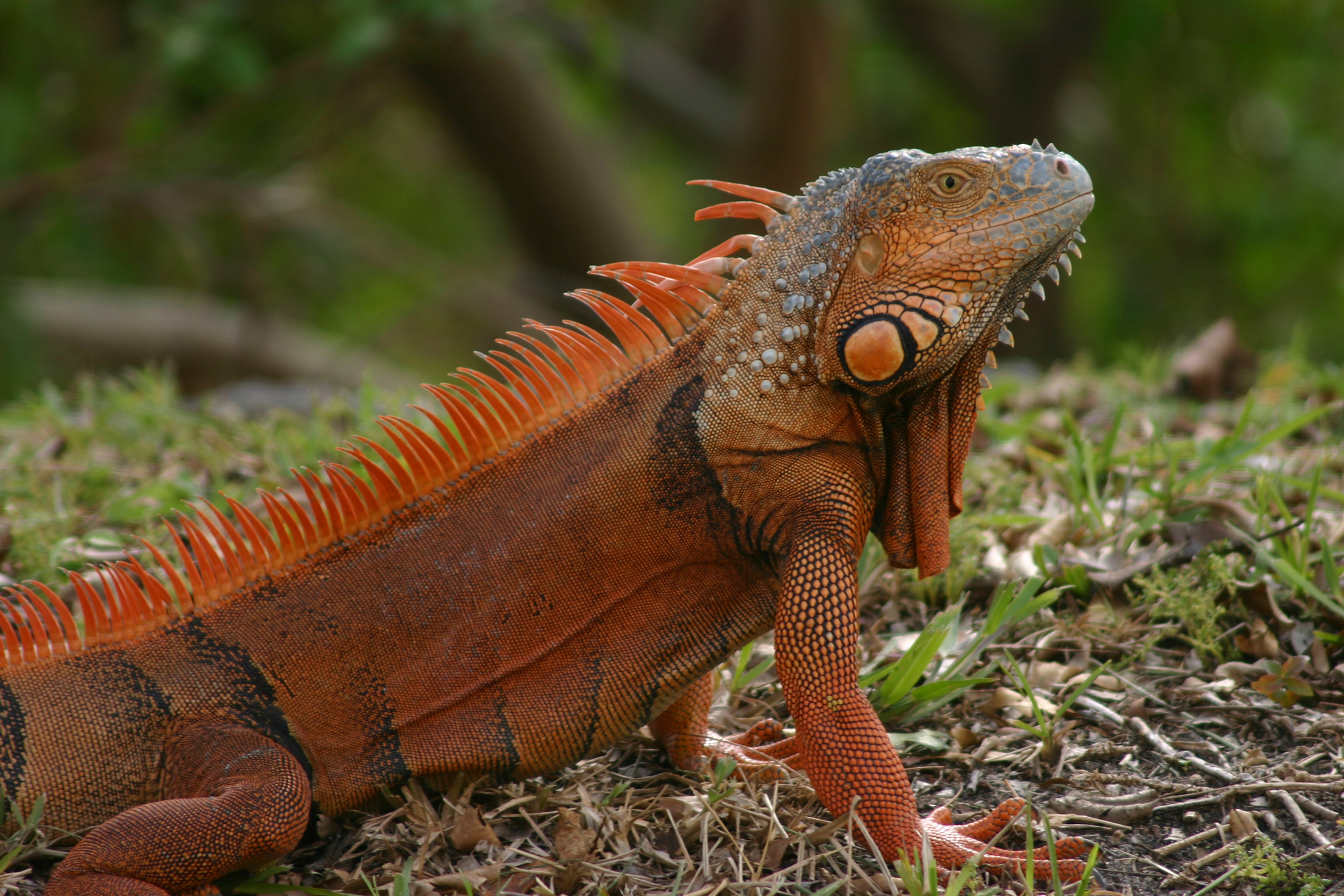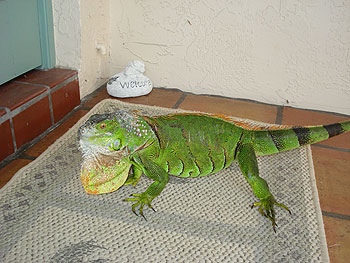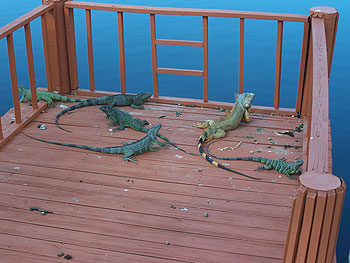
Florida Museum photo by Kenneth Krysko
Health and safety risks from non-native iguanas in south Florida have prompted a University of Florida researcher and his team to recommend widespread use of artificial nest boxes to control the reptiles’ population growth.
Homeowners and property managers have grown weary of green iguanas eating shrubs and damaging foundations and seawalls with subterranean nests and tunnels. The 3- to 5-foot-long lizards also create human health risks by defecating in swimming pools and on sidewalks, docks and moored boats, and endanger drivers when crossing or basking on roads.
The nest boxes are designed to humanely capture the troublesome lizards and their eggs, said Florida Museum of Natural History herpetologist Kenneth Krysko, lead author of a study published in the September edition of Iguana: Conservation, Natural History and Husbandry of Reptiles. This is the first study to describe the natural history of the green iguana (Iguana iguana) and its expanding geographic range in south Florida. The lizards are native to central America down to Brazil and the Caribbean Islands.
“Extensive use of artificial nest boxes by private property owners and land managers could potentially make a big dent in their population,” Krysko said.
The study recommends the nest boxes in addition to traditional capture methods such as live traps, snares and nooses, and also advises south Florida residents to “plant vegetation that lacks showy flowers and colorful fruit,” because such ornamentals are preferred iguana food.
“People are just frustrated, having to wrap wire netting around their hibiscus and ornamentals, keeping their plants in jail so to speak,” said Kim Gabel, a Monroe County environmental horticulture extension agent who also said she receives several calls a month from residents trying to figure out what to do about their yards.
Wild green iguanas were first found in Miami-Dade County in 1964. They were later documented in Collier (1998), Lee (2000), Monroe (2001), Palm Beach (2003) and Broward counties. Between 1992 and 2006, Krysko’s team compiled 3,169 photographs and specimens of green iguanas in these counties.

Florida Museum Photo by Carl May
Florida Fish and Wildlife Commission biologist and study co-author Kevin Enge said he was contacted by the Florida Keys Invasive Exotics Task Force in 2003, when the group was concerned with green iguana impacts in their area. He suggested the possibility of creating artificial nest mounds to capture iguana eggs as a control method in areas where suitable nesting habitat was limited because of underlying limestone.
“The nest-box idea evolved from this suggestion, and we hope it proves effective,” Enge said.
Some people are more tolerant of iguanas than others said FWC Exotic Species Coordinator Scott Hardin.
“But green iguanas top my list of nuisance complaints from individuals and legislative calls in Palm Beach and Broward counties,” Hardin said.
The study documents details about green iguana reproduction, possible ecological impacts and nuisance effects. Researchers say a combination of natural range expansion and illegal releases by pet owners fueled the species’ migration from Miami to surrounding counties.
“Trapping and removing iguanas only works to a certain extent,” Krysko said. “But the boxes are flexible because they can be used during nesting season from December to May to remove eggs, and year-round to catch both juveniles and adults. They also may be used for spiny-tailed iguanas, another type of large, non-native lizard in Florida.”
One adult iguana can lay between 10 and 70 eggs per year, Krysko said.
“If a landowner is squeamish about euthanizing the lizards, then an iguanas’ tendency to reuse a nest site in subsequent breeding seasons may increase the box’s efficiency at capturing eggs, and helping to control population growth that way,” Krysko said.

Florida Museum photo by Anthony Flanagan
Green iguanas likely became established in south Florida due to a combination of mild weather and people releasing, protecting and feeding them. Releasing a captured non-native species is illegal, so those who use the artificial nest boxes are responsible for euthanizing the iguanas. The FWC approves of several methods, including freezing the reptile or having a veterinarian perform lethal injection.
The study’s authors recommend a simple nest-box design: a 6-inch diameter pipe about 2 feet long leading below ground to a 15-by-8-by-4-inch chamber and a lid permitting above-ground access and monitoring. The box can be constructed from plastic, rubber or fiberglass to be lightweight, moveable and reusable.
“The biggest obstacle to overcome with iguanas is public education because people don’t realize they are introduced and not native,” said co-author Ellen Donlan of the South Florida Water Management District.
An independent scientist said he is eager to see how well the nest boxes work.
“The historical background for the green iguana invasion of Florida is interesting and the description of the problem itself is valuable,” said Gregory Watkins-Colwell, a senior museum assistant in the division of vertebrate zoology at the Yale Peabody Museum of Natural History. “I suspect it will not only be a valuable tool for controlling the invasive populations of iguanas in the Florida Keys, but also in other areas of Florida where high density of introduced fire ants may limit the available nest sites.”
According to the study, green iguanas’ largely plant-based diet, combined with their 5.6-square-mile territory, make them potentially significant seed-dispersers for non-native plants — further complicating the enmeshed ecological web of non-native and native species in the region. Juvenile green iguanas eat insects, bird eggs, tree snails, carrion, vegetative shoots, leaves, blossoms and fruit whereas adults feed mostly on plants and flowers. Potential predators of green iguanas are raccoons, spotted skunks, fish crow, black and turkey vultures, feral pigs and domestic dogs.
“Don’t forget, green iguanas are also good to eat,” Krysko said. “There are a lot of good recipes floating around on the Internet for iguana entrées.” Krysko cautioned that although non-indigenous species have no protection status in our state, they must be killed humanely. He also said people should be mindful to not trespass or collect them from a national or state park.
Additional co-authors include Jason Seitz of Creative Environmental Solutions, an environmental consulting firm, and Elizabeth Golden of Bill Baggs Cape Florida State Park, located on Key Biscayne in Miami-Dade County.
Learn more about the Herpetology Collection at the Florida Museum.